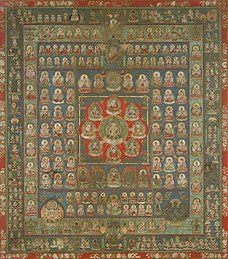Womb Realm

In Vajrayana Buddhism, the Womb Realm (Template:Lang-sa, Template:Lang-ja taizōkai) is the metaphysical space inhabited by the Wisdom Kings. The Womb Realm is based on the Mahavairocana Tantra. The name of the mandala derives from chapter 2 of the sutra, where it is said that the buddha Mahāvairocana revealed the mandala's secret teachings to his disciple Vajrasattva from his "womb of compassion".[1] In other translations, the term matrix realm or Matrix Mandala are used.[2]
The Womb Realm is a very popular subject for mandalas, and along with the Diamond Realm (vajradhātu) Mandala forms the Mandala of the Two Realms. This mandala, along with the Diamond Realm, form the core of Japanese Tendai and Shingon Buddhist rituals, including abhisheka "initiation". In this ritual, new initiates are blindfolded and asked to toss a flower upon a mandala. Where the flower lands helps decide which Buddhist figure the student should devote themselves to.[3]
In traditional Shingon halls, the Womb Realm Mandala is hung on the east wall, symbolizing the young stage of Mahāvairocana.[4]In this setting, the Diamond Realm Mandala is hung on the west wall symbolizing the final realization of Mahāvairocana.
Womb Realm map
| |||||||||||||||||||||||
See also
References
- ^ Abe, Ryuichi (1999). The Weaving of Mantra: Kukai and the Construction of Esoteric Buddhist Discourse. Columbia University Press. ISBN 0-231-11286-6.
- ^ Hakeda, Yoshito S. (1972). Kūkai and His Major Works. Columbia University Press. p. 26. ISBN 0-231-05933-7.
- ^ Hakeda, Yoshito S. (1972). Kūkai and His Major Works. Columbia University Press. p. 44. ISBN 0-231-05933-7.
- ^ Hakeda, Yoshito S. (1972). Kūkai and His Major Works. Columbia University Press. p. 87. ISBN 0-231-05933-7.
Further reading
- ten Grotenhuis, Elizabeth (1999). Japanese Mandalas: Representations of Sacred Geography. University of Hawaii Press. pp. 58–77. ISBN 978-0-8248-2081-7.
{{cite book}}: Invalid|ref=harv(help)
External links
- Mandala of the Womb World Japan, Kamakura period, 13th - 14th century Dharmapala Thangka Centre
- The Diamond and Womb World Mandalas Dharmapala Thangka Centre
- Flying Mountains and Walkers of Emptiness: Toward a Definition of Sacred Space in Japanese Religions History of religions 1982
